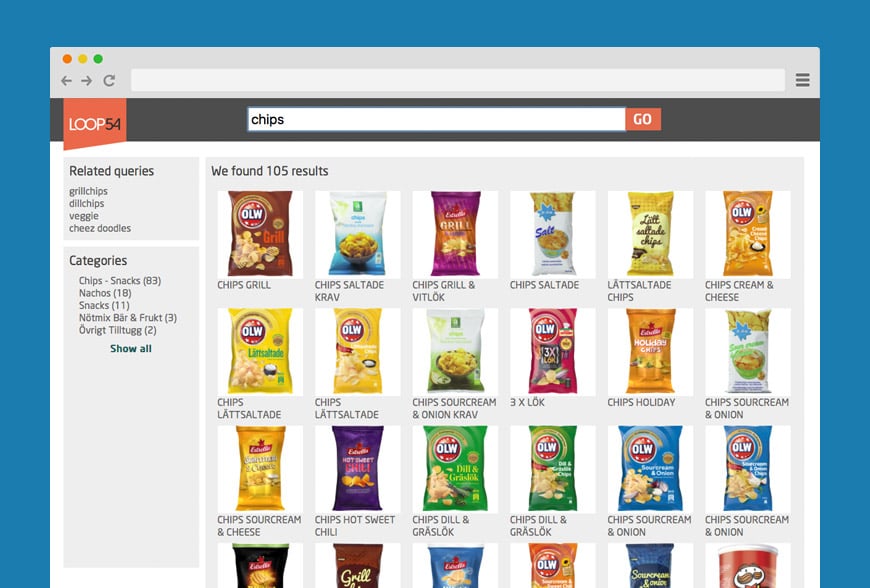Before returning results, the engine can count the unique occurrences of certain product attributes and return this data along with the results. The engine can also be configured so that a client can filter the results based on attributes before the engine returns them. This can be used to present the user with, for instance, a list of categories that products in the result belong to, so that the user can choose which results to see, we call this facets.
Faceting is used to filter the search results and to give the user a sense of in what part of the store they ended up with their query. The facets can be put either at the side or on top of the results.
You need to decide which attributes that are to be used as facets. In the example we've used Manufacturer and Category, two common ones along with price. You should not use too many types of facets, as it will only confuse the user. Depending on the store, 2-3 is usually sufficient. Under each faceting type we recommend showing five options along with a button saying "show all" (if there are more). The facets come sorted from us in a list with a number attached to each entity. Those numbers represent the amount of products that fit the facet. That number should also be displayed to the user. See example below.

if(isset($_GET{"categories"}))
$request->setValue("Faceting.Category",explode(",",$_GET{"categories"}));if(isset($_GET{"categories"}))
$request->setValue("Faceting.Category",explode(",",$_GET{"categories"}));if(isset($_GET{"manufacturers"}))
$request->setValue("Faceting.Manufacturer",explode(",",$_GET{"manufacturers"}));The engine will always respond with lists of available facets - these can be used to display the faceting links to the visitor. The names of the lists will be the same as the attribute from where the data is taken. In this case the data is taken from the attributes "Category" and "Manufacturer". The value of each key is the number of times the facet is represented in the search results.
//if there are faceting categories
if($response->hasData("Category"))
{
$facetItems = $response->getCollection("Category");
if(count($facetItems)>0)
echo "Categories: ";
foreach($facetItems as $item)
echo $item->key . ": " . $item->value . " "; //key is the facet name, value is the number of products in the facet
}
//if there are faceting manufacturers
if($response->hasData("Manufacturer"))
{
$facetItems = $response->getCollection("Manufacturer");
if(count($facetItems)>0)
echo "Brands: ";
foreach($facetItems as $item)
echo $item->key . ": " . $item->value . " "; //key is the facet name, value is the number of products in the facet
}The naming convention for the faceting list on the request is "Faceting." + [name_of_attribute]. In the following code example it will be "Faceting.Category" since we want to facet on the attribute called "Category".
POST to helloworld.54proxy.com/search
{
"UserId" : "helloworlduser",
"IP" : "127.0.0.1",
"QueryString" : "fruit",
"DirectResults_FromIndex" : 0,
"DirectResults_ToIndex" : 9,
"RecommendedResults_FromIndex" : 0,
"RecommendedResults_ToIndex" : 9,
"Faceting.Category" : ["Fruits"]
}POST to helloworld.54proxy.com/search
{
"UserId" : "helloworlduser",
"IP" : "127.0.0.1",
"QueryString" : "fruit",
"DirectResults_FromIndex" : 0,
"DirectResults_ToIndex" : 9,
"RecommendedResults_FromIndex" : 0,
"RecommendedResults_ToIndex" : 9,
"Faceting.Category" : ["Fruits"],
"Faceting.Manufacturer" : ["The banana company", "Fruits n Veggies"]
}The engine will always respond with lists of available facets - these can be used to display the faceting links to the visitor. The names of the lists will be the same as the attribute from where the data is taken. In this case the data is taken from the attributes "Category" and "Manufacturer". The value of each key is the number of times the facet is represented in the search results.
Response: 200 OK
{
"Success": true,
"HeroId": "The Warrior of the Dull Cupboard",
"Data": {
"MakesSense": true,
"DirectResults_TotalItems": 3,
"RecommendedResults_TotalItems": 0,
"RelatedQueries": [],
"DirectResults": [...],
"RecommendedResults": [],
"Category": [
{
"Key": "Fruits",
"Value": 3
},
{
"Key": "Fruit",
"Value": 1
}
],
"Manufacturer": [
{
"Key": "Fruits n Veggies",
"Value": 2
},
{
"Key": "The banana company",
"Value": 1
}
]
}
}
The naming convention for the faceting list on the request is "Faceting." + [name_of_attribute]. In the following code example it will be "Faceting.Category" since we want to facet on the attribute called "Category".
The API V2X-based Java Connector is no longer supported.
You can view code examples for the V3-based Connector at
https://github.com/LoopFiftyFour/Java-ConnectorThe API V2X-based Java Connector is no longer supported.
You can view code examples for the V3-based Connector at
https://github.com/LoopFiftyFour/Java-ConnectorThe engine will always respond with lists of available facets - these can be used to display the faceting links to the visitor. The names of the lists will be the same as the attribute from where the data is taken. In this case the data is taken from the attributes "Category" and "Manufacturer". The value of each key is the number of times the facet is represented in the search results.
The API V2X-based Java Connector is no longer supported.
You can view code examples for the V3-based Connector at
https://github.com/LoopFiftyFour/Java-ConnectorThe naming convention for the faceting list on the request is "Faceting." + [name_of_attribute]. In the following code example it will be "Faceting.Category" since we want to facet on the attribute called "Category".
The API V2X-based .NET Connector is no longer supported.
You can view code examples for the V3-based Connector at
https://github.com/LoopFiftyFour/.NET-ConnectorThe API V2X-based .NET Connector is no longer supported.
You can view code examples for the V3-based Connector at
https://github.com/LoopFiftyFour/.NET-ConnectorThe engine will always respond with lists of available facets - these can be used to display the faceting links to the visitor. The names of the lists will be the same as the attribute from where the data is taken. In this case the data is taken from the attributes "Category" and "Manufacturer". The value of each key is the number of times the facet is represented in the search results.
The API V2X-based .NET Connector is no longer supported.
You can view code examples for the V3-based Connector at
https://github.com/LoopFiftyFour/.NET-Connector
Product overview
Technology